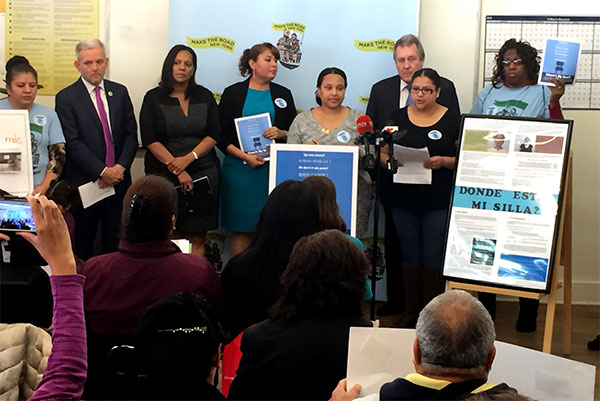
Protesting school overcrowding in Queens
All parents in New York City deserve the peace of mind that their children will be able to attend a school where they can thrive and grow. Unfortunately, following years of neglect from the Bloomberg administration, our city's school system is plagued by school overcrowding and excessive class sizes, where hundreds of thousands of our children simply don't have adequate space to learn.
With education a top priority for the city, it's critical that our leaders take strong action to address the chronic underfunding of our city's school infrastructure. Key to addressing this issue is investing sufficient capital resources in the city budget, as well as improving the current school planning process, which is broken.
Recently, we've had some good news. When the city Department of Education (DOE) released its school capital plan, it included a commitment from Mayor de Blasio to invest nearly $900 million in additional resources to build more school seats. In the same plan, the DOE raised its needs assessment to 83,000 additional seats, given enrollment projections and existing overcrowding. This is closer to the 100,000-seat figure that Class Size Matters estimated in its recent report, "Space Crunch." Together, these two adjustments are a welcome acknowledgement of the crisis in school overcrowding, and we applaud them.
But more should be done. The number of new seats in the capital plan is 49,000—only about 59 percent of the DOE's own admitted need—and New York City's population is growing faster than any other large city in the nation. The mayor is now urging the City Council to adopt rezoning plans to accelerate the construction of thousands of new affordable and market-rate housing units, which will increase pressure on our school system. At this critical moment, the city has a real opportunity to address housing and education together.
Right now, more than half a million students are crammed into over-utilized schools, according to DOE data. In many cases, this means excessive class sizes of 30 or more, a loss of art, music, or science rooms, and a lack of dedicated spaces for students to receive counseling or mandated special education services – no less the wraparound services inherent in the community school model.
According to the analysis in a recent report by Make the Road New York—"Where's My Seat?"—immigrant communities have especially egregious overcrowding problems and even greater unmet needs in the DOE capital plan. In many of the schools in these neighborhoods, children are forced to eat their lunch as early as 10 a.m. or are bused to schools far away from their homes. Many do not have adequate opportunity for physical education because there is not enough space in their gyms.
We need to build, lease, and expand more schools. At least the 83,000 seats that the DOE projects are necessary. In addition, the process of school planning and siting must be made more efficient. There are many communities, like Sunset Park, which have suffered from extreme overcrowding for a decade or more, even though funding to build more schools in the neighborhood has existed in the capital plan, because the School Construction Agency has not been able to site a single one.
According to the DOE, only 15 percent of the school seats needed by 2019 have sites identified and are in the process of being designed. In seven districts, that percentage is zero. The city will fall even further behind in creating seats if the mayor's rezoning proposals are adopted, unless much more is done to build and site schools. A recent Environmental Impact Statement for the East New York rezoning proposal found it would exacerbate school overcrowding, and, along with other changes, drive high school overcrowding in the borough to 109 percent of capacity. Yet the DOE capital plan does not include a single Brooklyn high school to be built.
That is why we are urging the City Council, along with the mayor, to create a commission or task force of experts and stakeholder groups, to propose reforms to the school planning process, so that schools must be built along with housing, instead of decades afterwards. Among the issues to be considered would be reforms to the zoning process, including whether the threshold to consider the need for a new school should be lowered – especially when the schools are already overcrowded; whether the formula used by City Planning to estimate the impact of new housing on schools needs to be updated; whether the city should require impact fees from developers and/or use eminent domain more frequently; and how the trends in lost seats, utilization rates, and enrollment could be made more transparent and more accurate through regular reporting by the DOE.
As Mayor de Blasio repeated in his recent State of the City speech, the goal across our city must be to ensure that neighborhoods thrive. There cannot be successful neighborhoods unless there are schools with enough space for the children in every community across the city to learn and prosper. It's time to invest all the necessary resources and improve the school planning process to ensure the bright future that all of our children deserve.
***
Leonie Haimson is the Executive Director of Class Size Matters. Javier H. Valdés is the Co-Executive Director of Make the Road New York. On Twitter: @leoniehaimson @javierhvaldes.




